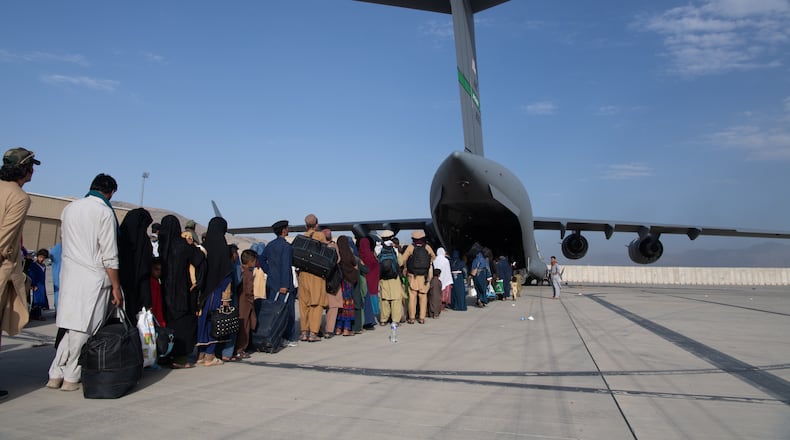As the 20-year war in Afghanistan arrived at its final hours on Monday, the Air Force Reserve Command confirmed that the 445th Airlift Wing, based at Wright-Patterson Air Force Base, played a role in the withdrawal and evacuation of Americans and Afghan nationals who allied with the U.S. in the past two decades.
In announcing the completion of the evacuation and war effort. Gen. Frank McKenzie, head of U.S. Central Command, said the last planes took off from Kabul airport at 3:29 p.m. Washington time, or one minute before midnight in Kabul.
The airport had become a U.S.-controlled island, a last stand in a 20-year war that claimed more than 2,400 American lives.
The Air Force Reserve Command contributed 17 aircraft to the ongoing effort, including C-17 Globemaster III’s, C-130 Hercules, C-5M Super Galaxy’s, and the KC-10 Extender “with 73 aircrews and hundreds of maintenance, security, medical and support personnel,” the command said.
The focus of the U.S. evacuation was increasingly on getting the last Americans out. Senior administration officials said Sunday that the United States has the capacity to evacuate the approximately 300 U.S. citizens remaining in Afghanistan who want to leave before President Biden’s deadline today.
“This is the most dangerous time in an already extraordinarily dangerous mission these last couple of days,” said America’s top diplomat, Secretary of State Antony Blinken.
The steady stream of U.S. military jets taking off and landing at Hamid Karzai International Airport in Afghanistan’s capital continued Monday even after rocket fire targeted the airport and rockets hit a nearby neighborhood. U.S. Central Command spokesman Bill Urban said five rockets targeted the airport and a U.S. defensive system on the airfield known as a Counter Rocket, Artillery and Mortar System, or C-RAM, was employed against them. He said there were no U.S. casualties and the airfield continued to operate. Further details were not immediately available. The White House said Biden had been briefed on the rocket attack.
Biden’s national security adviser, Jake Sullivan, said Sunday that for those U.S. citizens seeking immediately to leave Afghanistan by the looming deadline, “we have the capacity to have 300 Americans, which is roughly the number we think are remaining, come to the airport and get on planes in the time that is remaining.”
Interviews with 445th personnel involved with efforts in Afghanistan are not being granted now, a spokeswoman for the 445th said Monday. The withdrawal effort ends today.
In many cases, Air Force Reserve Airmen blended into active duty, Guard and Reserve crews involved in the overall effort, the command said.
“The United States is the only nation capable of rapidly deploying forces to provide nonstop airlift operations at this scale,” Lt. Gen. Richard Scobee, Air Force Reserve Command commander and chief of the Air Force Reserve, said in a statement. “It would not be possible without the support of our total force — active, Guard and Reserve citizen airmen — seamlessly integrating to execute the mission.”
Credit: U.S. Central Command Public Affa
Credit: U.S. Central Command Public Affa
“Once again, our Air Force Reservists are proudly answering our nation’s call, responding in less than 24 hours,” he added.
Nearly 60% of America’s mobility capacity lies in the air reserve component, “underscoring the importance of a total force approach,” said Col Mark Villacis, the command’s chief of mobility operations division. “An airlift operation of this historic magnitude can only be executed with total force integration.”
Local reaction to withdrawal
Local Afghanistan veterans and Gold Star families are wrestling with thorny feelings as the massive withdrawal and evacuation effort winds down.
Jim and Leslie Groves are the parents of Army Chief Warrant Officer III James E. Groves III, who was killed in March 2013 in Kandahar, Afghanistan. Their son was 37 at that time.
Jim Groves said he and his wife Leslie, of Kettering, professed to having “mixed feelings” on the topic. Mrs. Groves called it a “touchy subject.”
“I just think it’s a sad day for America,” Jim Groves said Monday.
“We share a loss of the 13 lives,” Jim Groves said, referring to the 13 American service members killed at the Kabul airport Thursday. “And it also brings back our own loss, as well, and takes us back to that day.”
Credit:
Credit:
What concerns him most: “We pulled those people out (U.S. military forces) before we pulled out civilians. I don’t understand that logic. Common sense would tell you, if you’re in a burning house, you don’t call the firemen away.”
Jim Groves said he does not necessarily have a problem with the idea of a withdrawal. But he said he has concerns about the manner in which this withdrawal was conducted.
The Associated Press contributed to this story.
About the Author



